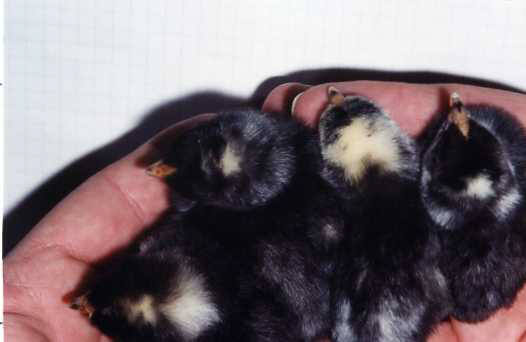Although it doesn’t seem to be commonly known among poultry fanciers, Dominiques do have sex-linked characteristics that are easily observed at hatching.
The cockerels have the definitely yellow shanks and toes typical of the breed, while the pullets show a grayish or blackish coloration on the shanks and toes, particularly on the front of the shanks and top of the toes. The degree of this darkish coloration will vary from pullet to pullet. The color difference between pullets and cockerels becomes less noticeable as the chicks mature.
Roger and Carol Voter conducted a study, observing and labeling many chicks. The records of individual birds where checked after it was possible to positively identify the sex and this model of sexing newly hatched Dominiques was accurate more than 95% of the time. The author uses the same method with Dominique bantams with the same success.

Equally reliable is the sexing of chicks based on the shape of the light colored spot on the top of the chick’s head. As reported by F.P. Jeffrey, at hatching the male head spot, for the most part, is larger and more scattered than the one on the female which tends to be small (though not always) and more compact — free of black areas — see photographs below.


In a study of Barred Plymouth Rocks whose genetics for barring came from its Dominique ancestry, it is reported that when 73 chicks were sexed using a combination of shank color and head spots, 29 were classified as females. Mr. F.P. Jeffrey further reported that all were sacrificed and there were no errors. Using a combination of shank color and head spot size and distribution it is possible for breeders to determine the chicks’ sex with a high degree of accuracy.
There is one final word of caution however. The above photos are of chicks from the same strain Dominiques. If you are comparing chicks from more than one source you should place more emphasis on the head-spot method as the various strains have a high degree of variability in leg color.